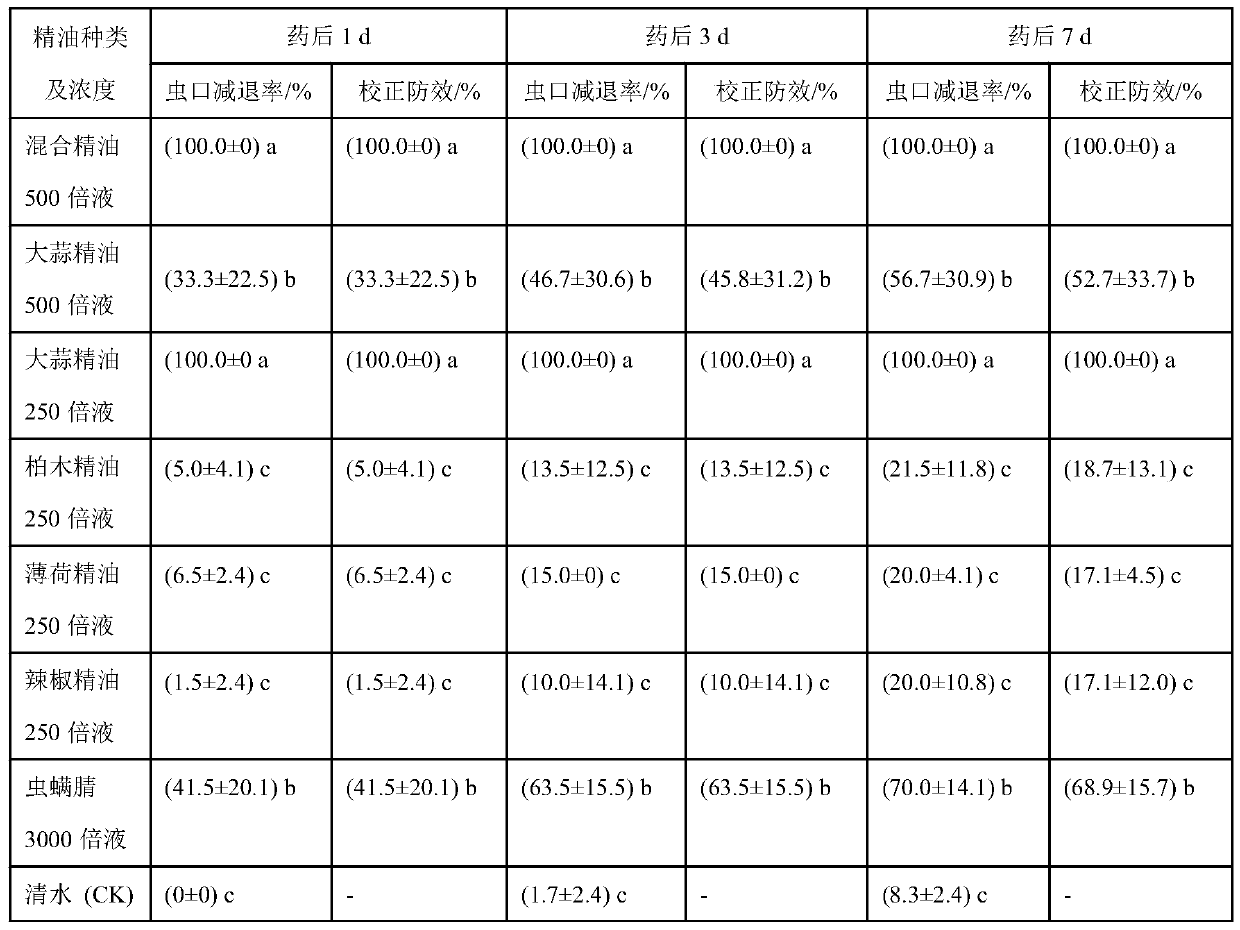A kind of method for using plant essential oil to prevent and control the gray tea foot moth
The technology of plant essential oil and tea chia moth is applied in the field of tea tree pest control, which can solve the problems of excessive pesticide residues in finished tea and pest resistance, etc., and achieve the effect of high ecological and social benefits.
- Summary
- Abstract
- Description
- Claims
- Application Information
AI Technical Summary
Problems solved by technology
Method used
Image
Examples
Embodiment 1
[0026] During the outbreak of the gray tea-foot moth in the tea garden in summer, the control area was evenly sprayed on the leaves of the tea trees according to the amount of water per mu, and the survival rate of the gray tea-foot moth was statistically calculated before watering, 1d, 3d and 7d after water spraying. 100%, 110.5%, 132.7% and 204.8%, which are used as blank controls for statistics on the control effect of the control moth. The treatment area was sprayed with 500 times of plant essential oil (garlic essential oil: cypress essential oil: peppermint essential oil: pepper essential oil = 5:2:2:1), before spraying, 1d, 3d and 7d after spraying, respectively, to investigate gray tea feet. According to the number of moth populations, the corrected control effects of 1d, 3d and 7d after treatment were 61.6%, 88.5% and 96.4%, respectively.
Embodiment 2
[0028] In the tea garden (20 mu) where the gray tea-foot moth occurred seriously in the previous year, 5 gray tea-foot moth sex pheromone traps were evenly arranged, and the lure cores were replaced regularly to monitor the occurrence regularity of the gray tea-foot moth. After harvesting the spring tea (April 20), at the 2nd instar stage of the gray tea-foot moth larvae, evenly spray plant essential oils (garlic essential oil: cypress essential oil: peppermint essential oil: pepper essential oil = 5:2:2:1) 500 times Liquid, randomly sampled 10 points (1 meter of tea line) in the 1d, 3d and 7d after the drug, the average statistical control effect was 59.3%, 85.6% and 99.1%, respectively. After that year, no prevention and control measures were carried out for the tea garden cichlid moth. The monitoring results showed that the damage of the gray tea cricket moth did not exceed the control index in that year, which was significantly better than the chemical control effect in pre...
Embodiment 3
[0030] In the previous year, the tea garden (800 mu) where the black tea-foot moth occurred seriously was evenly divided into 10 plots, and one gray tea-foot moth sex pheromone trap was arranged in each plot, and the lures were replaced regularly to monitor the occurrence of gray tea-foot moth. After harvesting the spring tea (May 2-3), evenly spray plant essential oil (garlic essential oil: cypress essential oil: peppermint essential oil: pepper essential oil = 5:2:2:1) 500 times liquid, random sampling of 5 points (1 meter of tea row) in each plot to count the control effect on 1d, 3d and 7d after treatment, the average control effect of 50 statistical points was 53.9%, 82.4% and 93.2% respectively. Afterwards, monitoring the damage of the gray tea-foot moth, the results showed that the damage of the gray tea-inch moth (2nd instar larva) exceeded the control index only on September 5 of the year, and the annual damage peak 2 times was significantly lower than the 3 times of c...
PUM
 Login to View More
Login to View More Abstract
Description
Claims
Application Information
 Login to View More
Login to View More - R&D
- Intellectual Property
- Life Sciences
- Materials
- Tech Scout
- Unparalleled Data Quality
- Higher Quality Content
- 60% Fewer Hallucinations
Browse by: Latest US Patents, China's latest patents, Technical Efficacy Thesaurus, Application Domain, Technology Topic, Popular Technical Reports.
© 2025 PatSnap. All rights reserved.Legal|Privacy policy|Modern Slavery Act Transparency Statement|Sitemap|About US| Contact US: help@patsnap.com

